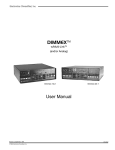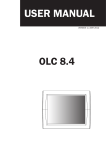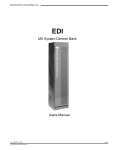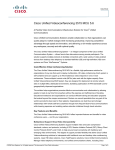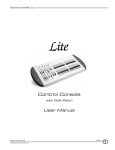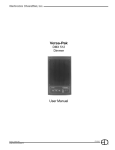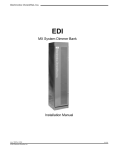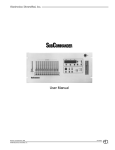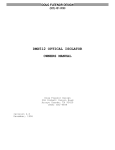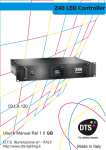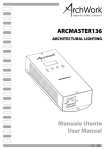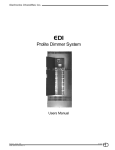Download SCRimmer IITM User Manual
Transcript
SCRimmer IITM SCRimmer II TM with Multi-LinkTM User Manual 070-0520 Reision 4, September 1998 ©1998, Electronics Diversified, Inc. 1 SCRimmer IITM Introduction Description This User's Manual is supplied with your Scrimmer II. Copies of this manual may be obtained from Electronics Diversified, Inc., for a nominal charge. It is recommended that you copy those portions of this manual applicable to your present use in the installation, maintenance or repair and preserve the original in a safe place. Copyright 1998, by Electronics diversified, Inc. All rights reserved. No part of this Manual may be reproduced by any means, graphic, electronic, or mechanical, including photocopying, recording, taping, or information storage and retrieval systems, without the express written permission of Electronics Diversified, Inc., except in connection with installation, repair and maintenance of installed Scrimmer II Power Packs. The SCRimmer II with Multi-Link dimmer pack is a compact lighting control system. A variety of plug-in solid-state dimmer modules with ratings from 1,000 to 12,000 watts are available. With Multi-Link, a variety of control formats are supported. It is recommended that you read the following instructions before operating your dimmer pack for the first time. Location: Although very efficient, solid-state dimmers generate heat. Be sure a free flow of air is allowed through the ventilation openings on the front and rear of the cabinet. Locate the dimmer pack close to the power source. Either avoid long power cable runs or increase the input power wire size. Dimmer Type: This dimmer is designed to properly dim 120VAC incandescent or quartz lamps. Low voltage lamps operated through a standard (non-electronic) transformer with a 120VAC primary may also be operated. Do Not connect any other type of load such as motors or fluorescent lamps to this dimmer. Table of Contents Description . . . . . . . . . . . . . . . . . . . . . . . . . . . . . . . . . . . . . . . . . 2 Front Panel . . . . . . . . . . . . . . . . . . . . . . . . . . . . . . . . . . . . . . . . 2 Rear Panel . . . . . . . . . . . . . . . . . . . . . . . . . . . . . . . . . . . . . . . . . 4 Input Power Wiring . . . . . . . . . . . . . . . . . . . . . . . . . . . . . . . . . . 4 Three-Phase Wiring . . . . . . . . . . . . . . . . . . . . . . . . . . . . . . 4 Single-Phase Wiring . . . . . . . . . . . . . . . . . . . . . . . . . . . . . . 5 Input Control Connections . . . . . . . . . . . . . . . . . . . . . . . . . . . . . 5 Analog Control . . . . . . . . . . . . . . . . . . . . . . . . . . . . . . . . . . 5 Analog Connector . . . . . . . . . . . . . . . . . . . . . . . . . . . . . . . 5 Connector Wiring . . . . . . . . . . . . . . . . . . . . . . . . . . . . . . . . 5 Multiplex Control . . . . . . . . . . . . . . . . . . . . . . . . . . . . . . . . . 6 Multi-Link Connectors . . . . . . . . . . . . . . . . . . . . . . . . . . . . . 7 USITT DMX-512 Digital . . . . . . . . . . . . . . . . . . . . . . . . . . . 7 USITT AMX-192 Analog Multiplex . . . . . . . . . . . . . . . . . . . 7 Fiber-Link Optical Multiplex . . . . . . . . . . . . . . . . . . . . . . . . 7 Multiplex Cables . . . . . . . . . . . . . . . . . . . . . . . . . . . . . . . . . 7 Self Test . . . . . . . . . . . . . . . . . . . . . . . . . . . . . . . . . . . . . . . . . . . 7 Dimmer Output Test . . . . . . . . . . . . . . . . . . . . . . . . . . . . . . . . . 7 Lamp Preheat . . . . . . . . . . . . . . . . . . . . . . . . . . . . . . . . . . . 8 Calibration . . . . . . . . . . . . . . . . . . . . . . . . . . . . . . . . . . . . . . . . . 8 High End Calibration . . . . . . . . . . . . . . . . . . . . . . . . . . . . . 8 Low End Calibration . . . . . . . . . . . . . . . . . . . . . . . . . . . . . . 8 Wall Mounting . . . . . . . . . . . . . . . . . . . . . . . . . . . . . . . . . . . . . . 9 Solid-State Relay Replacement . . . . . . . . . . . . . . . . . . . . . . . . 9 Troubleshooting Guide . . . . . . . . . . . . . . . . . . . . . . . . . . . . . . 10 Maintenance . . . . . . . . . . . . . . . . . . . . . . . . . . . . . . . . . . . . . . 10 Service . . . . . . . . . . . . . . . . . . . . . . . . . . . . . . . . . . . . . . . . . . . 10 Registration . . . . . . . . . . . . . . . . . . . . . . . . . . . . . . . . . . . . . . . 11 Power Source: This dimmer is designed to operate on 120 volts, 60Hz, AC power. This dimmer should be connected to a molded-case circuit breaker properly sized for the load. Supply Cord: The dimmer power cord is not supplied. Refer to the INPUT Power Wiring section for proper wiring. WARNING: Do not connect this Dimmer to other than the specified voltage, or to direct current. Front Panel 1. Input Power Error Indicator: This indicator will light if there is voltage between the neutral conductor and the dimmer chassis. IMPORTANT! If this indicator is on, disconnect power immediately and check for improper input power wiring. Refer to the INPUT POWER WIRING section. WARNING: Maximum ambient operation and storage environment for this equipment is 104°F (40°C), with 90% humidity, non-condensing. Extreme caution is advised when having liquids, food and cigarettes around any equipment. During severe electrical storms, equipment should be disconnected. Failure to adhere to these requirements may result in malfunction or serious damage. 2. 3. 2 Phase Change Plug: On phase-change models, this plug allows the dimmer pack to be wired for either single-phase or three-phase power. Dimmer Module: The plug-in dimmer modules contain the power components of each individual dimmer circuit. SCRimmer IITM Front Panel (cont'd) 4. Dimmer Circuit Breakers: One fully magnetic circuit breaker is supplied for each dimming circuit. Turn off the corresponding breaker when re-lamping or connecting loads. 5. Control Power Switch: Turn on this switch to power the control electronics. When this switch is off, the dimmer will not respond to any external control signals and the dimmer preheat is off. 6. Power Indicators: These green indicators will light when power is applied to the corresponding phases. All three lights should light on threephase dimmers, and lights 1 and 2 should light on singlephase dimmers. 7. Control Power Fuses: These three fuses protect the Multi-Link control module. 8. Dimmer Output Test Buttons/Status Indicators: Each yellow indicator will light as bright as the output of the individual dimmer. When the button is pressed in, the corresponding dimmer will be forced to full output and the yellow indicator will be at maximum brightness. 9. Analog Control Input: Connect the analog cable from an analog 0- +10V controller here. 11. Dimmer Pack Number: These two thumbwheel switches select the dimmer pack address for multiplexed dimmer formats. 12. Configure Button: This pushbutton is used to enter new multiplex data formats, self-test patterns, or different dimmer pack addresses. Press this pushbutton after any change is made in multiplex data formats, self-test patterns, or dimmer pack addresses. 13. Multiplex Control Input: Connect the multiplex cable from the control console here. 14. Multiplex Control Output: This connector is paralleled to the Multiplex Control Input connector. Use this connector to add additional dimmers. 15. Multiplex Signal Presence Indicator: The yellow indicator lights when a valid multiplex signal is received. 16. Dimmer Overtemp Indicator: This red indicator will light when the dimmer pack is shut down due to an over-temperature condition. The dimmer pack will re-energize when it has cooled down to an acceptable temperature. 17. Preheat Level: This control is used to set the preheat level of the lamps. Turn it clockwise to increase the preheat level. 18. Calibration Access Plate: Removal of this plate allows access to calibration potentiometers and test points. Refer to Calibration section. 10. Multiplex Signal Format Switch: Set this switch to "D" for USITT DMX-512 digital, or "A" for AMX-192 control formats. 14 10 9 7 12 ØA MULTIPLEX 18 15 1 2 13 14 ØB 8 6 16 17 13 3 4 5 15 16 PREHEAT 6 17 18 4 7 8 9 10 11 12 19 20 21 22 23 24 SCRIMMER II CONTROL POWER 3Ø OFF CONFIG. ØC 1 AMP 125VAC 2 3 1Ø INPUT POWER ERROR MCU24/L MUX 1 C DA FORMAT ANALOG 3 ON PACK NUMBER H 1 2 3 H 1 2 3 GND 2 1 5 11 OT Multi-LinkTM SPU 24-2 ELECTRONICS DIVERSIFIED, INC. HILLSBORO, OREGON 97124 24 2.4KW 120VAC CKTS. O N O N O N O N O N O N O N O N O N O N O N O N O N O N O N O N O N O N O N O N O N O N O N O N O F F O F F O F F O F F O F F O F F O F F O F F O F F O F F O F F O F F O F F O F F O F F O F F O F F O F F O F F O F F O F F O F F O F F O F F 1 2 3 4 6 7 9 10 19 20 21 22 23 24 5 8 11 12 13 14 3 15 16 17 18 SCRimmer IITM Rear Panel 1. Convenience Outlet: External devices of up to 20 amps may be connected here. 2. Circuit Breaker: This circuit breaker provides branch circuit protection for the convenience outlet. 3. Dimmer Outputs: Loads should be at least 25 watts. 1 IMPORTANT! Solid-state dimmers are sensitive to resistance and the resulting voltage drops in the power feed cable. Excessive voltage drops may cause the dimmers to interact and flicker. This is especially true of the neutral conductor. The neutral conductor must be at least the same size as the line conductors. EDI recommends that the size of the neutral conductor be125% of the line conductors. 3 2 CONVENIENCE/LOAD TEST 20 AMP A 21 B A 17 B A 13 B A 9 B A 5 B A 1 B A 22 B A 18 B A 14 B A 10 B A 6 B A 2 B A 23 B A 19 B A 15 B A 11 B A 7 B A 3 B B A 20 B A 16 B A B A B A A 24 12 8 4 Three-Phase Wiring -- 120/208 VAC Three-phase wiring has three seperate hot wires and a neutral. 1. Connect the Ground wire to the lug next to the terminal block. This unit must be grounded. B 2. Connect the Neutral wire to the "N" terminal. 3. Connect the Phase A wire to the "Ø A" terminal. Connect the Phase B wire to the "Ø B" terminal. Connect the Phase C wire to the "Ø C" terminal. Neutral IMPORTANT! Phase B Phase A Turn off the correspoding circuit breaker when relamping or connecting loads. Phase C Double-check all connections, and make sure all terminals are tightly secured before replacing cover. Tighten the cable clamp and connect the cable to a suitable power source. Apply power to the dimmer and check the Input Power Indicator. If it is on, the dimmer is miswired. Turn off power immediately and check the input power wiring. Turn on the Control Power switch and check the three green power indicators. All three indicators should light. Connect the loads and turn on all of the circuit breakers. The dimmer is now ready to use. Input Power Wiring It is strongly recommended that the input power wiring be installed by a qualified electrician. This unit must be connected to a grounded power source! If a grounded power source is not available, contact a qualified electrician. IMPORTANT! Before connecting the input power, make sure the power source is turned off. Set all breakers and the control power switch to the off position. Unscrew and remove the dimmer cover. The line input terminal block is located on the right side of the dimmer. MPORTANT! Do not connect this dimmer pack to Delta configuration three-phase power sources. The input power requirement for this unit varies with the model. Table 1 gives the input power requirements and suggested wire size for type W wire. For other types of input power wires, consult the National Electric Code. Route the feed cable through the cable clamp and make the required connections to the terminal block and ground lug inside. Snug down all terminal and ground lug screws firmly, watching for stray wire strands which could cause shorts. Replace the cover and tighten the cable clamp. The SCRimmer II with Mulit-Link dimmer can be operated on single- or three-phase power. Each is connected in a different way. Refer to the following instructions for proper connections. NOTE: Table 1 is intended for portable installations and shows the minimum acceptable wire sizes for individual type W conductors in free air. If distance from the power source to the dimmer is greater than 50 feet, the wire size will have to be increased. For other types of wires or permanent installations, consult the National Electric Code for proper wire types and sizes. 4 SCRimmer IITM TABLE 2 TABLE 1 Dimme Model Line Current SPP 24-1.2 SPP 24-1.8 SPP 24-2 SPP 12-2 SPP 12-3 SPP 06-6 SPP 06-7 SPP 06-12 80 A 120 A 160 A 80 A 120 A 100 A 120 A 100 A Minimum Wire Size (Type W) No. 6 AWG No. 2 AWG No. 1 AWG No. 6 AWG No. 2 AWG No. 4 AWG No. 2 AWG No. 4 AWG Dimmer Model Line Current SPP 24-1.2 SPP 24-1.8 SPP 24-2 SPP 12-2 SPP 12-3 SPP 6-6 SPP 6-7 120 A 180 A 240 A 120 A 180 A 150 A 180 A Minimum Wire Size (Type W) No. 2 AWG No. 1/0 AWG No. 3/0 AWG No. 2 AWG No. 1/0 AWG No. 1 AWG No. 1/0 AWG Input Control Connections This dimmer may be controlled by either an analog output controller 0- +10 volt D.C. or one of three multiplexed output controllers. The following sections describe all control formats. Single-Phase Wiring -- 120/240 VAC Single-phase wiring has two seperate hot wires and a neutral. 1. Connect the Ground wire to the lug next to the terminal block. This unit must be grounded. Analog Control This dimmer is equipped with a male 25-pin "D" connector for operation from 0 to +10 Volt D.C. analog control voltages. 2. Connect the Neutral wire to the "N" terminal. 3. Connect the hot wires to the Line 1 and Line 2 terminals. Neutral No Connection Line 1 1. Connect the analog cable to the analog input connector. 2. Set the pack address switches to 00 to disable the selftest and multiplex input features. 3. Press the "Configure" button. Line 2 NOTE: If you are using the analog and multiplex controls at the same time, ignore steps 2 and 3. Analog Connector 25-pin D type Female mating connector: Cannon #DB-25S Double check all connections and make sure all terminals are tightly secured before replacing cover. Tighten cable clamp and connect cable to power source. Apply power to the dimmer and check the Input Power Indicator. If it is on, the dimmer is miswired. Turn off power immediately and check the input power wiring. Turn on the Control Power switch and check the three green power indicators. Indicators 1 and 3 should light. Indicator 2 should be off. Connect the loads and turn on all of the circuit breakers. The dimmer is now ready to use. 1 2 3 4 5 6 7 8 9 10 11 12 13 14 15 16 17 18 19 20 21 22 23 24 25 Connector Wiring The analog control signals are wired to the connector as in Table 3A. If the dimmer you are using is a Model SPP 6-6 (6kw) or SPP 6-7 (7.2kw), use Table 3B, and use Table 3C for SPP 312 (12kw) dimmer packs. On all models, control ground is connected to pin 25. IMPORTANT! The dimmer pack is intended to be operated from a 120/ 240 VAC power source (2 hots and 1 neutral). Do not connect this dimmer to a single 120 volt power source (1 hot and 1 neutral). The input power requirement for this unit varies with the model. Table 2 gives the input power requirements and suggested wire size for type W wire. For other types of input power wires, consult the National Electric Code. TABLE 3A Analog Connector Wiring (12 and 24 dimmer models) Dimmer Number 1 2 3 4 5 6 7 8 9 10 11 12 NOTE: Table 2 is intended for portable installations and shows the minimum acceptable wire sizes for individual type W conductors in free air. If distance from the power source to the dimmer is greater than 50 feet, the wire size will have to be increased. For other types of wires or permanent installations, consult the National Electric Code for proper wire types and sizes. 5 Control Pin 1 2 3 4 5 6 7 8 9 10 11 12 Dimmer Control Number Pin 13 13 14 14 15 15 16 16 17 17 18 18 19 19 20 20 21 21 22 22 23 23 24 24 Control Ground 25 SCRimmer IITM Dimmer Number 1 2 3 4 5 6 Ground TABLE 3B TABLE 4B Analog Connector Wiring Dimmer Pack Address Table (6-dimmer models) (6- dimmer models) Control Pin 1 3 5 7 9 11 25 Dimmer Number 1 2 3 Ground Control Pin 1 5 9 25 TABLE 3C Analog Connector Wiring (3-dimmer models) Dimmer Number 1 2 3 Ground Control Pin 1 3 5 25 Multiplex Control The Multi-Link controller may be configured for different control formats. When using the multiplex control option, the dimmer "Pack Number" thumbwheels must be set to the proper value. NONE 1-12 13-24 25-36 37-48 49-60 61-72 73-84 85-96 97-108 109-120 121-132 133-144 145-156 157-168 169-180 181-192 193-204 205-216 217-228 229-240 241-252 22 23 24 25 26 27 28 29 30 31 32 33 34 35 36 37 38 39 40 41 42 22 23 24 25 26 27 28 29 30 31 32 33 34 35 36 37 38 39 40 41 42 127-132 133-138 139-144 145-150 151-156 157-162 163-168 169-174 175-180 181-186 187-192 193-198 199-204 205-210 211-216 217-222 223-228 229-234 235-240 241-246 247-252 (3- dimmer models) Pack Address 00 01 02 03 04 05 06 07 08 09 10 11 12 13 14 15 16 17 18 19 20 21 (12- and 24-dimmer models) 00 01 02 03 04 05 06 07 08 09 10 11 12 13 14 15 16 17 18 19 20 21 NONE 1-6 7-12 13-18 19-24 25-30 31-36 37-42 43-48 49-54 55-60 61-66 67-72 73-78 79-84 85-90 91-96 197-102 103-108 109-114 115-120 121-126 Dimmer Number TABLE 4C TABLE 4A Pack Address 00 01 02 03 04 05 06 07 08 09 10 11 12 13 14 15 16 17 18 19 20 21 Pack Address Dimmer Pack Address Table Dimmer Pack Address Table Dimmer Number Dimmer Number SPP 3-12 (12kw) dimmer packs using an MCU-3 control module are in groups of three. Use Table 4C for proper addressing. NOTE: Dimmer pack numbers are in groups of twelve. Pack number 01 is for dimmers 1-12, 02 is for dimmers 13-24, and so on. Table 4A gives the corresponding dimmer numbers for all valid dimmer pack addresses. Pack Address Pack Address Dimmer Number 253-264 265-276 277-288 289-300 301-312 313-324 325-336 337-348 349-360 361-372 373-384 385-396 397-408 409-420 421-432 433-444 445-456 457-468 469-480 481-492 493-504 Dimmer Number NONE 1-3 4-6 7-9 10-12 13-15 16-18 19-21 22-24 25-27 28-30 31-33 34-36 37-39 40-42 43-45 46-48 49-51 52-54 55-57 58-60 61-63 Pack Address Dimmer Number 22 23 24 25 26 27 28 29 30 31 32 33 34 35 36 37 38 39 40 41 42 64-66 67-69 70-72 73-75 76-78 79-81 82-84 85-87 88-90 91-93 94-96 97-99 100-102 103-105 106-108 109-111 112-114 115-117 118-120 121-123 124-126 Usually, the first dimmer pack (dimmers 1-12) is set to 01, the second dimmer pack (dimmers 13-24) to 02, and so on. On 24 dimmer models, each dimmer pack uses two numbers, The first pack should be set to 01 (dimmers 1-24), the second pack to 03 (dimmers 25-48), etc. Whenever the dimmer pack number is changed, the Configure button must be pressed to enter the change. If a pack is set to 00, the Multiplex signal is disabled. SPP 6-6 and 6-7 dimmer packs using an MCU-6 control module are in groups of six. Use Table 4B for proper addressing. 6 SCRimmer IITM NOTE: If the control power switch is off, or power is disconnected to the dimmer pack, the Fiber-Link signal received at the IN connector, will not be transmitted by the OUT connector. In order to use the Fiber-Link multiplex format, an optional Fiber-Link module must be installed. This module has only fiber-optic connectors, not Multi-Link connectors. Therefore, Multi-Link and Fiber-Link dimmers may not be interchanged unless the control console has dual output. Multi-Link Connectors 5-pin XLR type mating connectors: Female connector Male connector (to next dimmer pack) (from console) Switchcraft No. A5F Switchcraft No. A5M 1 2 3 4 5 5 4 3 2 1 Multiplex Cables Standard Multi-Link Cable is used to connect the dimmer pack to USITT DMX-512, or Multi-Link compatible consoles. This cable is also used to interconnect packs for all multiplex formats. Wiring Connections: 1. Analog Ground 2. Clock/Data 3. Clock/Data + 4. Analog Multiplex 5. Overtemp Ground Data Data+ AMX Overtemp USITT DMX-512 Digital Multiplex The USITT DMX-512 Digital multiplex format will allow up to 512 dimmers to be controlled from a single cable. In addition to the digital signal, the SCRimmer II with Multi-Link sends an overtemp signal to the control console in the event of an overtemp condition. 1. Set the multiplex signal fromat switch to D (for Digital multiplex). 2. Set the desired pack number (see Multiplex Control section). 3. Press the Configure button. 4. Connect a USITT DMX-512 compatible control cable from the control console to the multiplex control input connector. SHIELD Ground Data Data+ AMX Overtemp FROM CONSOLE Male Connector WIRE Belden #9842 TO DIMMERS Switchcraft #A5M or Alpha #5272 Switchcraft #A5F F e m a l e Connector Strand CD80 to Multi-Link Adapter Cable Strand CD-80 to Multi-Link adapter cable is required for Strand consoles with smaller 4-pin MINI-XLR-type connectors. Use this adapter to connect the first dimmer pack to the console. Additional dimmer packs may be added by using standard MultiLink cables. Ground Clock Clock+ Analog FROM CONSOLE Male Connector Switchcraft #TA4ML USITT AMX-192 Analog Multiplex The Multi-Link AMX-192 analog multiplex format will allow up to 192 dimmers to be controlled from a single cable. 1. Set the multiplex signal format switch to A (for Analog mulitplex). 2. Set the desired pack number. The AMX-192 standard will only support 192 dimmers. The maximum pack address number that can be used is 16. 3. Press the Configure button. 4. Connect an AMX-192 adapter control cable from the control console to the multiplex control input connector. SHIELD WIRE Belden #9842 or Alpha #5272 Ground Clock Clock+ Analog TO DIMMERS Female Connector Switchcraft #A5F Self Test The Multi-Link system has three built-in test patterns. The patterns are enabled by selecting dimmer pack numbers of 50, 60, and 70. To enable a self-test pattern, 1. Select the desired pattern 50 - One dimmer on at a time. 60 - Build (starts with dimmer 1 and adds on additional dimmers). 70 - All dimmers on at once. 2. Press the Configure button. The self-test will start immediately. The right hand thumbwheel switch may be changed to vary the speed of the test. 0 is the fastest, 9 is the slowest. Fiber-Link Optical Multiplex The Fiber-Link multiplex format will allow up to 512 dimmers to be controlled from a single fiber-optic cable. 1. Set the desired pack number (see Multiplex Control section). 2. Press the Configure button. 3. Connect a Fiber-Link multiplex cable from the control console to the fiber-optic receiver (labeled IN). 4. Additional dimmer packs may be daisy-chained by running a Fiber-Link multiplex cable from the fiberoptic transmitter (labeled OUT) to the fiber-optic receiver (labeled IN) on the next dimmer. Dimmer Output Test There is a yellow button on the front panel for each dimmer channel. Pressing it will cause that dimmer to immediately go to full intensity. Pressing the button again will resume normal operation of that channel. The yellow indicator inside each test button shows the same percentage of brightness as the corresponding output. 7 SCRimmer IITM Lamp Preheat The lamp preheat adjustment allows a small amount of current flow through the lamp filaments at all times. This preheat (warming current) reduces the shock to the filaments when the lamps are suddenly turned on to full. Increasing the preheat level will significantly increase lamp life, especially in applications where the lamps are rapidly flashed on and off. Turn the lamp preheat clockwise to increase the lamp preheat and counter-clockwise to reduce it. For optimum preheat adjustment, turn the control all the way clockwise and then slowly turn it counter-clockwise until the lamps stop glowing. Wall Mounting Mount the dimmer to the wall with the front panel facing either right or left as shown. Allow 12" clearance on all sides, and 18" in front (circuit breaker) side to allow the plug-in dimmers and dimmer control module to be removed. Do not block any of the ventilation openings. Do not use aluminum wire. Do not run the control wiring and the line (or load) wiring together or in the same conduits. Avoid running common neutrals to the load wiring. 1234567890123456789012345678901212 1234567890123456789012345678901212 12" Clearance 1234567890123456789012345678901212 Brackets (4) 1234567890123456789012345678901212 (3 sides) 1234567890123456789012345678901212 1234567890123456789012345678901212 1234567890123456789012345678901212 1234567890123456789012345678901212 18" Ground Buss 1234567890123456789012345678901212 1234567890123456789012345678901212 1234567890123456789012345678901212 Front SCRimmer II Rear 1234567890123456789012345678901212 1234567890123456789012345678901212 1234567890123456789012345678901212 1234567890123456789012345678901212 Neutral Buss 1234567890123456789012345678901212 1234567890123456789012345678901212 1234567890123456789012345678901212 1234567890123456789012345678901212 WALL 1234567890123456789012345678901212 Calibration This dimmer has been factory calibrated and should never require additional calibration. Before calibration is attempted, make sure that all other equipment has been checked for failure or malfunction, especially the control console. If the dimmer is ghosting (all lamps glowing), turn the preheat control counter-clockwise. The SCRimmer II with Multi-Link is designed to be calibrated for a 0- +10 volt analog control signal. If the dimmer is calibrated for other analog control levels, the digital formats (including the test modes) will not work properly. H 1 2 3 Calibration Controls H 1 2 3 High Cal. Phase A Low Cal. Phase B Low Cal. Phase C Low Cal. GND If common load neutrals absolutely must be run (retrofit situations), do not connect circuits of the same phase to the same common neutral wire. Do not run more than three dimmers (three-phase) or two dimmers (single-phase) on a common neutral wire. Choose the size of the neutral wire to handle 120% of the rated dimmer load. Refer to Table 5A for normal dimmer phasing. For SPP 6-6 and 6-7, use Table 5B. SPP 3-12 dimmers are each on a different phase. Control Ground Phase C Ramp Phase B Ramp Phase A Ramp High Calibration Test Point TABLE 5A Dimmer Phasing High End Calibration Remove the calibration access plate. Connect a digital voltmeter between the test point labeled H (high cal.) and GND. Adjust the H calibration potentiometer so meter indicates exactly 9.3 volts. (12-and 24-dimmer models) Dimmer Number 01 02 03 04 05 06 07 08 09 10 11 12 Low End Calibration Set the preheat control to ¼ of the way from full counterclockwise. Connect identical 100-500 watt clear lamps to dimmers 1, 5, and 9 (on six-dimmer modules, use 1, 3, 5). Adjust low cal potentiometer 1 until the lamp connected to dimmer 1 barely glows. Adjust low cal potentiometer 2 until the lamp connected to dimmer 5 glows at the same intensity as the lamp connected to dimmer 1. Adjust low cal potentiometer 3 until the lamp connected to dimmer 9 glows at the same intensity as the lamps connectd to dimmers 1 and 5. Reset the preheat control for the desired preheat level. The dimmer is now properly calibrated. ThreePhase Phase A Phase A Phase A Phase A Phase B Phase B Phase B Phase B Phase C Phase C Phase C Phase C Single Phase Line 1 Line 1 Line 1 Line 1 Line 1 Line 1 Line 2 Line 2 Line 2 Line 2 Line 2 Line 2 TABLE 5B Dimmer Phasing (6-dimmer models) 8 Dimmer Number 13 14 15 16 17 18 19 20 21 22 23 24 ThreePhase Phase A Phase A Phase A Phase A Phase B Phase B Phase B Phase B Phase C Phase C Phase C Phase C Single Phase Line 1 Line 1 Line 1 Line 1 Line 1 Line 1 Line 2 Line 2 Line 2 Line 2 Line 2 Line 2 Dimmer Number 1 2 3 4 5 6 Three Phase Phase A Phase A Phase B Phase B Phase C Phase C Single Phase Line 1 Line 1 Line 1 Line 2 Line 2 Line 2 SCRimmer IITM Solid-State Relay Replacement Determine which plug-in dimmer needs repairing and remove it from the dimmer pack. The solid-state relays are mounted on the heatsink. Quad dimmer modules have two solid state relays. Dimmers 1 and 2 are controlled by the relay with the white-withbrown stripe wire connected to it. Dimmers 3 and 4 are controlled by the relay with the white-with-orange stripe wire connected to it. Do not install a plug-in dimmer module with the cover removed. 1. Note the arrangement of the power connections (large wires) on the defective solid-state relay, then unplug the connections. 2. Note the orientation of the control connector, then unplug the connector. 3. Remove the relay by removing the two screws which secure it to the heatsink. 4. Apply a thin coating of heatsink compound to the bottom of the new solid-state relay and replace by following steps 1 - 3 in reverse order. 5. Replace the cover before reinstalling the dimmer module into the dimmer pack. Troubleshooting Guide Symptom Possible Cause Remedy Nothing works, green indicators 1, 2, and 3 are dark. Control power switch is off. Input power source is off. Turn on control power switch. Check input power source. Nothing works, green indicator 1 is dark, 2 and 3 are on. Phase A (Line 1) fuse blown. Phase A (Line 1) power source off. Replace fuse. Check input power source. Dimmers 5, 6, 7 & 8 don't dim correctly, or snap on instead of dimming. Phase B fuse blown. Phase B power source off. Single-phase dimmer pack wired to three-phase power. Replace fuse. Check input power source. Connect dimmer to single-phase power source. Green indicator 2 is off. Three-phase dimmer pack wired to single-phase power. Connect dimmer to three-phase power source. Dimmers 9, 10, 11 or 12 don't dim Phase C (Line 2) fuse blown. correctly, or snap on instead of dimming. Replace fuse. Green indicator 3 is off. Phase C (Line 2) power source off. Check input power source. A dimmer channel is always on and the corresponding output status indicator is on. Dimmer channel in test mode. Defective solid-state relay. Depress the corresponding button to clear the test. Replace the solid-state relay. A dimmer channel is always on and the corresponding output status indicator is off. Defective solid-state relay. Replace the solid-state relay. A dimmer channel is always off and the corresponding output status indicator is off. The dimmer module is not plugged in all the way. The solid-state relay control connector is loose, unplugged, or plugged in backwards. Defective solid-state relay. Make sure dimmer is firmly plugged in. Defective lamp fixture plugged into dimmer. Dimmer circuit breaker is off. Dimmer circuit breaker is tripped. Check the load with a known good fixture. A dimmer channel is always off, but the corresponding output status indicator operates properly. All of the lamps "ghost" (glow). Check control wiring connector to solid state relays. Replace the solid-state relay. Defective solid-state relay. Turn on the circuit breaker. Reset the circuit breaker by turning off and then on. Replace the solid-state relay. Lamp preheat set too high. Dimmer out of calibration. Rotate the preheat control counter-clockwise. Re-calibrate the dimmer. (cont'd) 9 SCRimmer IITM Troubleshooting Guide (cont'd) Symptom Possible Cause Remedy Lamps plugged into dimmers 1 - 4, or 5 - 8, or 9 - 12 ghost. The corresponding phase low end calibration is out of adjustment. Re-calibrate the dimmer. The multiplex signal indicator flashes, lamps flicker, or dimmers refuse to respond to multiplex signal. Dimmer address set to 00. Set the dimmer pack address to a valid number. Bad multiplex cable. Multiplex format set to wrong setting. Check the dimmer pack with a known good cable. Set the format switch to the proper format. Dimmer address set to test modes (50-70). Bad multiplex cable. Multiplex format set to wrong format. Set the dimmer pack address to a valid number. Lamps flash, flicker, or sequence. Check the dimmer pack with a known good cable. Set the format switch to the proper setting. The overtemp lamp is always on or comes on when a dimmer channel is brought up. The dimmer module is not plugged in all the way. Make sure dimmer is firmly plugged in. The dimmer pack overheats. The cooling vents are blocked. The dimmer pack is full of dust. Clear any obstructions to the cooling vents. Carefully remove dust and dirt with compressed air or a vacuum cleaner. Relocate the dimmer to a cooler location. The dimmer is in a very warm location. Lamps go out before the console sliders reach zero. Lamps are on full before console sliders reach full. Input power error light on. The analog control console is not set for 0 - +10V output. The low-end calibration is out of adjustment. Check the output from the console. The analog control console is not set for 0 - +10V output. The high-end calibration is out of adjustment. Check the output from the console. Faulty or incorrect input power wiring. Do not touch the dimmer pack or anything connected to it. Check for voltage between the ground and neutral conductor. Disconnect the power source and check all input power wiring. Re-calibrate the dimmer. Re-calibrate the dimmer. Maintenance Service Disconnect Power First! About once a year (or more frequently, if the Power Pack is used often), remove the modules and inspect the connector pins. Clean them with No. 400 or finer sandpaper and carefully spread the pins SLIGHTLY with a screwdriver. Disconnect power from the rack before cleaning pins in the housing. If the modules become clogged with air-born dirt, they should be vacuumed. This will increase cooling efficiency and prolong component life. EDI offers a 24 hour Service / Support Network. For technical questions about this product or operational assistance, ask for Customer Service at: . . . . 1-800-547-2690 You may communicate by FAX: . . . . . . . . . . . 1-503-629-9877 After Hours Emergency contact: . . . . . . . . . . . 1-503-645-5533 Ask for Emergency Assistance. Internet: . . . . . . . . . . . . . . . . . . . . . . . . . . . . www.edionline.com Internet E-Mail: . . . . . . . . . . . . . . . . . . . [email protected] If your SCRimmer Power Pack needs repair, call 503-645-5533 for a Return Materials Authorization number, and a shippping address will be furnished 10 SCRimmer IITM Attention SCRimmer II owners! Please return this registration card immediately. Your prompt attention to this matter will ensure your receiving updated technical information for this product as it becomes available. Please complete all information. Look for acknowledgment of your registration within 6-8 weeks. Name: _______________________________________________________ Title: ________________________________________________________ Facility and/or Company: ________________________________________ _____________________________________________________________ Street Address: _______________________________________________ _____________________________________________________________ City: ____________________________ State: ______ Zip: __________ Phone: ______________________________________________________ Fax: _________________________________________________________ E-mail: ______________________________________________________ CUT ALONG DOTTED LINE Web site: ____________________________________________________ ! Mail to: EDI User Manual Registration 1675 NW Cornelius Pass Road Hillsboro, Oregon 97124 or FAX to: (503) 629-9877 Revision 2, May 1998 11











